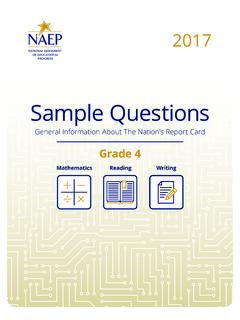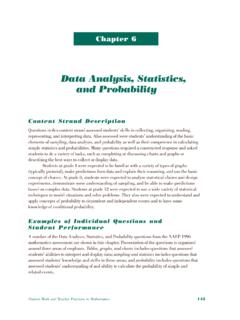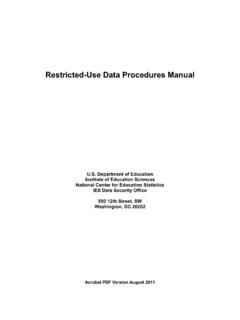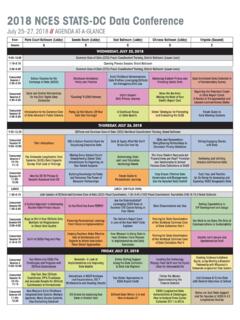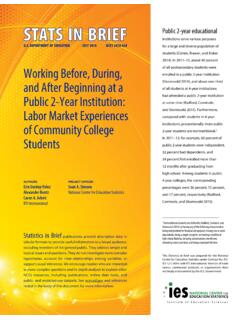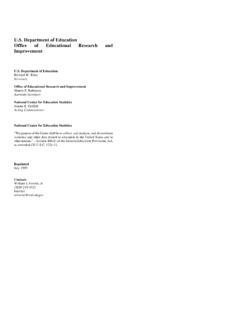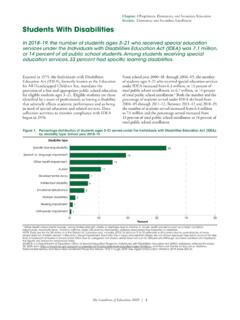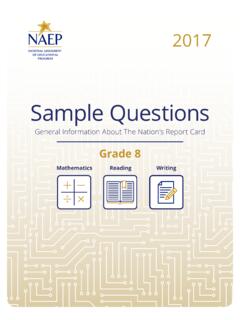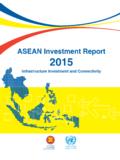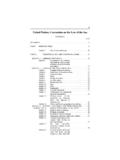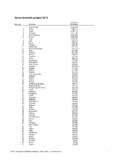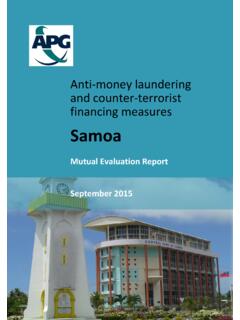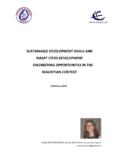Transcription of Financial Accounting for Local and State School …
1 Financial Accounting for Local and State School Systems: 2014 DEPARTMENT OF EDUCATIONNCES 2015 -347 Financial Accounting for Local and State School Systems: 2014 EditionMARCH 2015 Gregory S. AllisonUniversity of North CarolinaFrank JohnsonProject OfficerNational Center for Education StatisticsNCES DEPARTMENT OF Department of Education Arne Duncan SecretaryInstitute of Education Sciences Sue Betka Acting DirectorNational Center for Education Statistics Peggy G. Carr Acting CommissionerThe National Center for Education Statistics (NCES) is the primary federal entity for collecting, analyzing, and reporting data related to education in the United states and other nations. It fulfills a congressional mandate to collect, collate, analyze, and report full and complete statistics on the condition of education in the United states ; conduct and publish reports and specialized analyses of the meaning and significance of such statistics; assist State and Local education agencies in improving their statistical systems; and review and report on education activities in foreign activities are designed to address high priority education data needs; provide consistent, reliable, complete, and accurate indicators of education status and trends; and report timely, useful, and high quality data to the Department of Education, the Congress, the states , other education policymakers, practitioners, data users, and the general public.
2 Unless specifically noted, all information contained herein is in the public strive to make our products available in a variety of formats and in language that is appropriate to a variety of audiences. You, as our customer, are the best judge of our success in communicating information effectively. If you have any comments or suggestions about this or any other NCES product or report, we would like to hear from you. Please direct your comments toNCES, IES, Department of Education 1990 K Street NW Washington, DC 20006-5651M a r c h 2 015 The NCES Home Page address is NCES Publications and Products address is of trade names, commercial products, or organizations does not imply endorsement by the CitationAllison, ( 2015 ). Financial Accounting for Local and State School Systems: 2014 edition (NCES 2015 -347). Department of Education, National Center for Education Statistics.
3 Washington, DC: Government Printing ordering information on this report, write to ED Pubs, Department of Education Box 22207 Alexandria, VA 22304or call toll free 1-877-4ED-Pubs or order online at ContactFrank This handbook is one in a series of data handbooks published by the National Center for Education Statistics (NCES). It continues a half-century s tradition of sharing the best practices in data collection and reporting with the schools, School districts, and State agencies that are our partners in providing good information to manage, assess, and guide elementary and secondary education. In addition to this volume, NCES has produced the Handbooks Online tool to improve the consistency of data definitions and data maintenance, so that education data can be more accurately aggregated and analyzed. Handbooks Online contain data items, definitions, and a system of data item codes at the student, staff, School , School district, and State levels.
4 The Handbooks Online tool is updated as needed and is available at The data handbooks do not include every possible data element. They are intended, rather, as a set of data element definitions and suggestions for structuring a report or an electronic record system . However, every attempt has been made to include all of the data elements routinely required for federal education reporting. The rationale for this is that if these items are part of a comprehensive information system used for the daily management of schools and districts, they can be reported with minimal additional burden on teachers and principals. NCES and representatives of State and Local education agencies, as well as members of the research and statistical communities, have worked together through the National Cooperative Education Statistics system to improve the quality and comparability of data used for education policy decisions at all levels of government.
5 This handbook, like the other data handbooks published by NCES, was written through the efforts of education professionals from a range of backgrounds. Their input ensures that such products are useful for managing the daily business of schools and districts as well as for identifying the information needed for program monitoring and statistical purposes. iii Page intentionally left blank. iv Acknowledgments The 2014 edition of Financial Accounting for Local and State School Systems updates the 2009 and 2003 editions of the handbook. The 2003 edition was the work of the NCES National Forum on Education Statistics, Core Finance Data Task Force. That task force systematically rewrote nearly the entire text, incorporating new chapters and reviewing and revising the account code structure and account code definitions. The 2009 edition of the handbook incorporated changes resulting from the issuance of GASB Statements 40 through 47.
6 This edition incorporates changes resulting from the issuance of GASB Statements 48 through 70. NCES would like to thank all of the accountants and data coordinators in the State education agencies who have used previous editions of the handbook and have provided advice on improving and updating this edition . In particular, NCES would like to thank Peggy O Guin and Christine Davis of the California State Department of Education; Su McCurdy and Janice Evans of the Iowa State Department of Education; Glenda Rader of the Michigan State Department of Education; and Vaughn Altemus of the Vermont State Department of Education. v Page intentionally left blank. vi Contents Page Preface .. iii Acknowledgments .. v Chapter 1: Introduction .. 1 Major Changes and Chapter Highlights .. 1 Chapter 2: Financial Reporting Within a system of Education Information.
7 6 Background .. 7 Useful Applications of Education Information .. 9 Users of School Finance Information .. 11 Summary .. 12 Chapter 3: Budgeting .. 14 Budgetary Objectives .. 15 Budgetary Approaches .. 16 Operating Budget Responsibilities and Guidelines .. 20 Financial Forecasting and Planning .. 22 Planning for Annual and Multiyear Construction and Grant Programs .. 24 Budgets for Multiyear Construction Projects .. 24 Preparation of Construction Project Budgets and Related Financing .. 25 Summary .. 25 Chapter 4: Governmental Accounting .. 26 Governmental GAAP Hierarchy .. 28 Measurement Focus and Basis of Accounting .. 30 Fund Structure .. 31 Internal Control Structure .. 33 Other Issues Affecting Educational Entities .. 39 Conclusion .. 40 Chapter 5: Financial Reporting .. 41 Financial Statement Elements .. 42 Assets .. 42 Deferred Outflows and Inflows of Resources .. 60 Liabilities.
8 62 Fund Balance/Net Position .. 69 Revenues .. 72 Fund Financial Statements Reporting of Expenditures/Expenses .. 75 Government-Wide Statements Reporting of Expenses .. 78 Financial Statements .. 79 Conclusion .. 94 Chapter 6: Account Classification Descriptions .. 96 Fund Classifications .. 97 Program .. 100 Balance Sheet/Statement of Net Position .. 103 vii Classifications of Revenue and Other Financing Sources .. 112 Classifications of 123 Function .. 123 Object .. 135 148 Level of Instruction .. 149 Additional Classifications .. 150 Chapter 7: Cost Accounting and Reporting for Educational Programs .. 151 The Expanding Need for Greater Detail in Financial Reporting .. 151 Concepts of Program Cost Reporting by School .. 151 Analysis of Reported Costs .. 153 The Program Cost Reporting Structure .. 153 Use of Cost Reporting Software With Existing Data Systems .. 156 Direct Costs.
9 156 Indirect Costs .. 156 Summary of the Annual Program Cost Reporting Process .. 157 Analysis of Cost Reports .. 158 Conclusion .. 158 Chapter 8: Activity Fund Guidelines .. 159 Types of Activity Funds and Their Proper Classification .. 159 Controls for Establishing and Maintaining Activity Funds .. 161 Preparation and Review of Monthly Activity Fund Reports .. 164 .. 167 ReferencesSummary .. 169 Appendix A Summary of Account Code Changes Since 2009 .. A-1 Appendix B Ot her Resources .. B-1 Appendix C Gl ossary of Acronyms .. C-1 Appendix D Il lustrative Financial Statements for an Independent School District .. D-1 Appendix E Cr iteria for Distinguishing Equipment From Supply Items .. E-1 Reasons for Distinguishing Between Supplies and Equipment .. E-2 The Disadvantages of a Supply/Equipment List .. E-3 Criteria for Distinguishing Between Supply and Equipment Items.
10 E-3 Distinguishing Between Built-In and Movable Equipment .. E-4 Selecting the Level of Control for Supplies and Equipment .. E-6 Index .. Index-1 viii List of Exhibits Exhibits Page 1. Measurement focus and basis of Accounting for Financial statements .. 26 2. Financial statement components and primary user groups .. 37 3. Straight-line depreciation method .. 49 4. Accumulated depreciation method .. 49 5. Net position classification .. 63 6. Classification of revenues .. 66 7. Contents of a Comprehensive Annual Financial Report (CAFR).. 72 8. Measurement focus and basis of Accounting for Financial statements .. 78 9. Important distinctions between MD&A and letter of transmittal .. 84 10. Program cost report format .. 145 11. Cost analysis example .. 148 12. Lines of authority for student activity funds .. 152 Summary of Account Code Changes Since 2003 A-1. Changes to account code descriptions.
